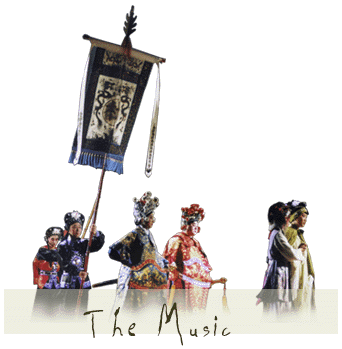
 |

There are more than 360 regional styles of Chinese opera. Given that the stories, movement, and costumes are similar from style to style, they are distinguished primarily by their music. In all, the Kunju opera repertory comprises some 1,200 arias. The common musical structures are Banqiangti and Qupaiti. Most Chinese operas use Banqiangti melodies, which have a structure of seven to ten words per verse. Kunju opera is the most typical Qupaiti music, an earlier and less common style than Banqiangti.
The musical structure of Qupaiti is marked by a close union of word and melody. In general, Qupaiti, which developed from the poetry of the Song Dynasty (960-1280), places strict constraints on the number and structure of words and sentences, and their tonal placement. The melodies of Qupaiti arias derive from the innate tones of the words, given the tonal nature of the Chinese language.
All Qupaiti are classified as Southern or Northern in style. The Southern style uses a five-tone scale and its melody is considered more elegant and romantic. By contrast, the Northern style, with a seven-tone scale, is more suited to heroic and martial themes. In general, each Kunju opera uses multiple Qupaiti, either Southern style, Northern style, or-as in The Peony Pavilion-a mix of the two.
It is not until 1792, almost two hundred years after the premiere of The Peony Pavilion, that we find a complete score for The Peony Pavilion in the Na Shu Ying Musical Score, a collection of operatic music on 24 wooden rolls edited by Ye Tang in the Qing Dynasty. Although it post-dates Wei Liangfu's formulation of Kunju music by two and a half centuries, the Na Shu King Musical Score is the oldest surviving source for Kunju music. Ye Tang was a famous opera singer in the city of Suzhou, where Kunju opera found its origins. He was a talented Kunju musician, not only performing Kunju in concert versions, but also recording and re-notating the musical scores. One of his innovations was a new method for indicating the first musical beat in each measure.
The music in the Na Shu Ying Musical Score was recorded in a linear notation beside the words, in a manner not unlike contemporary notation. The inclusion of The Peony Pavilion in the anthology meant that it became an influential work in later years. By the time the work was renotated by Yu Sulu, a member of the second generation of Ye Tang's students, The Peony Pavilion had come to be considered a canonical, classical work. Even today, the first scene given to every actress studying Kunju opera is "The Dream Interrupted" (Scene 10).
The musical aspect of the Lincoln Center Festival production of The Peony Pavilion is based on the Na Shu Ying Musical Score. The now-archaic notation is difficult to read, and it has been a demanding task to transcribe it into contemporary notation. For example, to allow the virtuoso performers room for improvisation, the old notation omitted rhythmic values for the second and fourth beats of the measure. Today, however, all the notes and rhythms of each note must be fully notated. In all of the work of transcribing and re-notating the score, the purpose has been not only to present it in the most authentic manner possible, but also to preserve The Peony Pavilion in an enduring form for future generations.
-Xin Qinghua